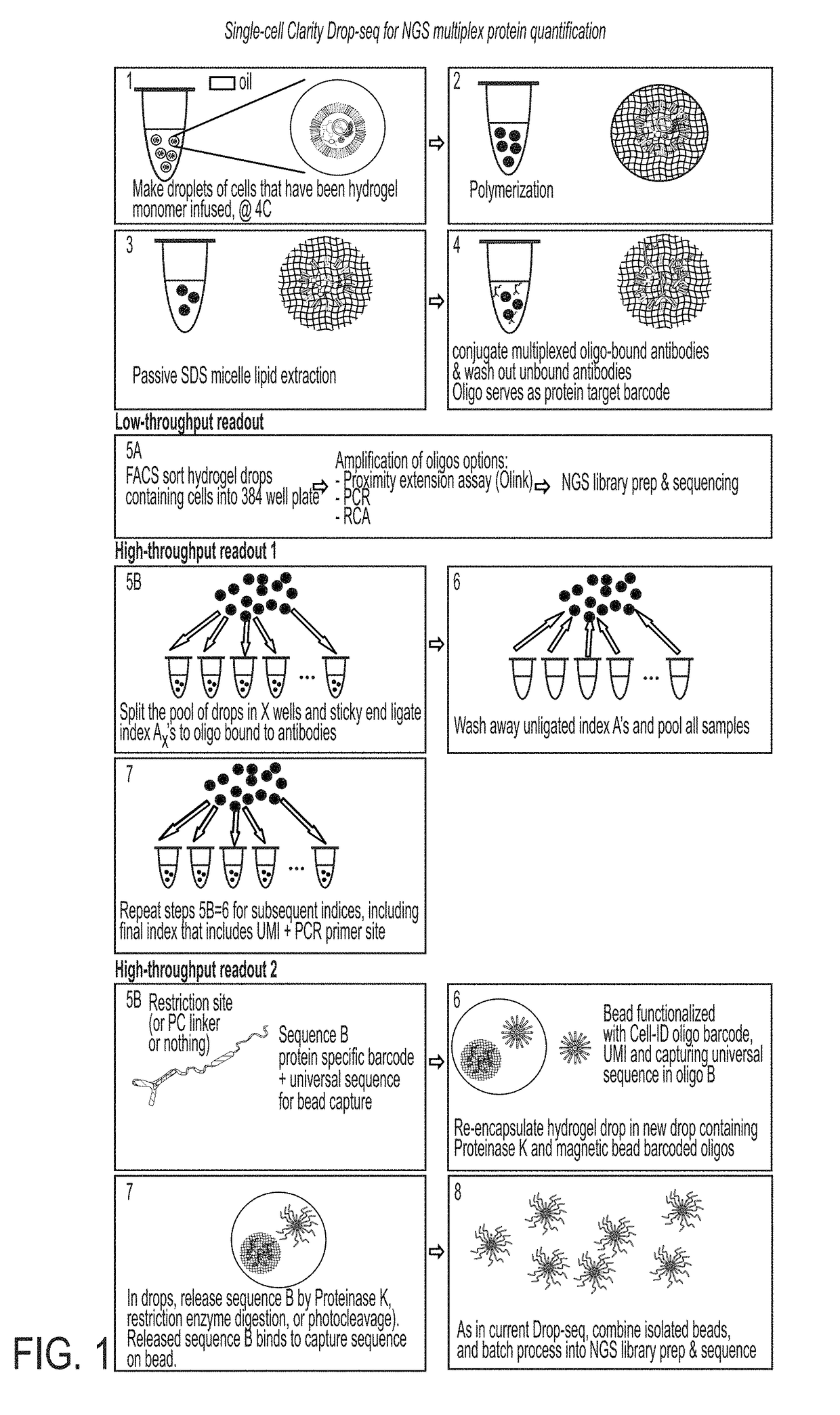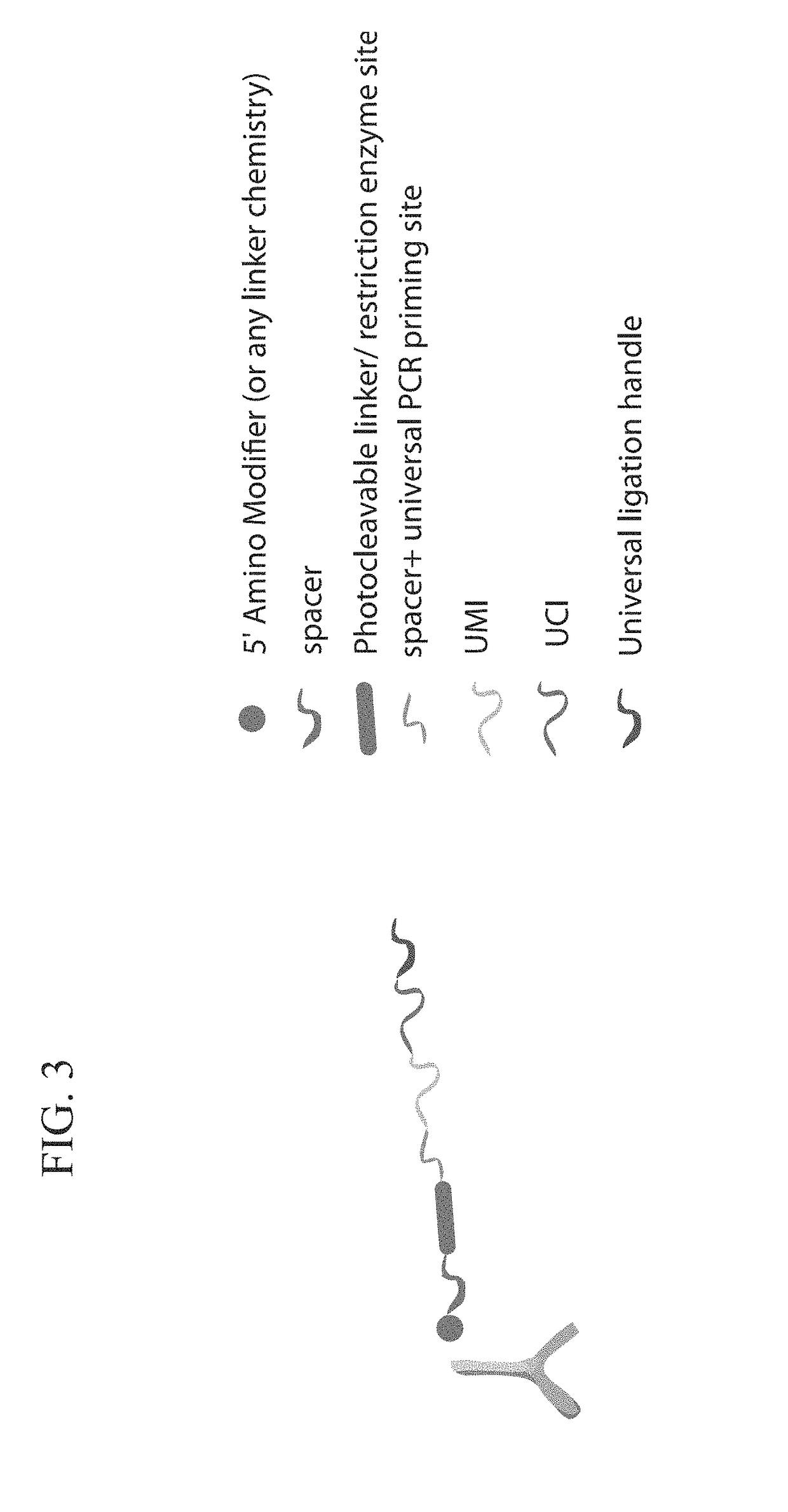Assays for massively combinatorial perturbation profiling and cellular circuit reconstruction
a combinatorial perturbation and profiling technology, applied in the field of combinatorial perturbation profiling and cellular circuit reconstruction, can solve the problems of inability to achieve the sheer number of mammalian cells required, remain an insurmountable stumbling block,
- Summary
- Abstract
- Description
- Claims
- Application Information
AI Technical Summary
Benefits of technology
Problems solved by technology
Method used
Image
Examples
example 1
Combinatorial Genetic Perturbations in Mouse Cells using CRISPR-Cas Mediated Multiple Gene Activation
[0761]A pooled perturbation assay is performed in mouse cells, using a CRISPR-Cas system, as decribed in Shalem O., Sanjana N E., Zhang F. High-throughput functional genomics using CRISPR-Cas9. Nat Rev Genet. May; 16(5):299-311. (2015). doi: 10.1038 / nrg3899. Epub 2015 Apr. 9. The pooled assay is designed to reach MOI values of 3-4, corresponding to orders 3-4 of genetic perturbations, concerning a total of 7,000 target genomic loci.
[0762]An sgRNA library is designed as described in Sanjana, N. E., Shalem, O. & Zhang, F. Improved vectors and genome-wide libraries for CRISPR screening. Nat Methods. 11, 783-784, doi:10.1038 / nmeth.3047 (2014); Konermann, S., Brigham, M. D., Trevino, A. E., Joung, J., Abudayyeh, O., Barcena, C., Hsu, P. D., Habib, N., Gootenberg, J. S., Nishimasu, H., Nureki, O. & Zhang, F. Genome-scale transcriptional activation by an engineered CRISPR-Cas9 complex. Natu...
example 2
Combinatorial Genetic Perturbations in Human Cells Using CRISPR-Cas Mediated Multiple Gene Knock-Outs
[0764]A pooled perturbation assay is performed in a human using a CRISPR-Cas system, as decribed in Shalem O., Sanjana N E., Zhang F. High-throughput functional genomics using CRISPR-Cas9. Nat Rev Genet. May; 16(5):299-311. (2015). doi: 10.1038 / nrg3899. Epub 2015 Apr. 9. The pooled assay is designed to reach MOI values of 2-3, corresponding to orders 2-3 of genetic perturbations regarding a total of 10,000 target genomic loci.
[0765]An sgRNA library is designed as described in Sanjana, N. E., Shalem, O. & Zhang, F. Improved vectors and genome-wide libraries for CRISPR screening. Nat Methods. 11, 783-784, doi:10.1038 / nmeth.3047 (2014); Shalem, O., Sanjana, N. E., Hartenian, E., Shi, X., Scott, D. A., Mikkelsen, T. S., Heckl, D., Ebert, B. L., Root, D. E., Doench, J. G. & Zhang, F. Genome-scale CRISPR-Cas9 knockout screening in human cells. Science. 343, 84-87, doi:10.1126 / science.12470...
example 3
Perturb-Seq: Pooled CRISPR Screens with Single Cell RNA-seq Readout
[0768]Applicants devised Perturb-seq by combining the design of a pooled CRISPR screen, where the identity of each perturbation is reported by a unique barcode for each guide that is assayed by sequencing, with massively-parallel, droplet-based scRNA-seq, as a rich genomic phenotype for each cell (FIG. 48A). In Perturb-seq, the sgRNA barcode is reported by a polyadenylated RNA, which is captured by single cell RNA-seq. Perturb-seq uses a CRISPR lentiviral vector that both delivers an sgRNA to a cell and reports on the identity of the delivered sgRNA by an expressed PolyAdenylated Perturbation Index (PAPI) (FIG. 48B). As in a typical pooled genetic screen, applicants first infect cells with a pool of lentiviruses, each carrying a construct for a particular guide. Depending on the multiplicity of infection (MOI), applicants expect a different distribution of the number of lentivirus genomic insertions (and hence sgRNAs...
PUM
| Property | Measurement | Unit |
|---|---|---|
| temperature | aaaaa | aaaaa |
Abstract
Description
Claims
Application Information
 Login to View More
Login to View More - R&D
- Intellectual Property
- Life Sciences
- Materials
- Tech Scout
- Unparalleled Data Quality
- Higher Quality Content
- 60% Fewer Hallucinations
Browse by: Latest US Patents, China's latest patents, Technical Efficacy Thesaurus, Application Domain, Technology Topic, Popular Technical Reports.
© 2025 PatSnap. All rights reserved.Legal|Privacy policy|Modern Slavery Act Transparency Statement|Sitemap|About US| Contact US: help@patsnap.com



